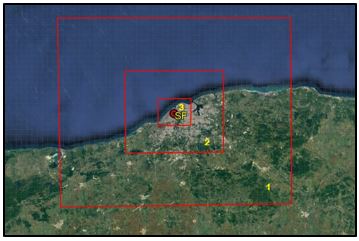Evaluation of the WRF as a tool to determine the performance of a photovoltaic system in clear sky conditions
Main Article Content
Abstract
In photovoltaic systems the evaluation of the efficiency of the plant during long periods is considered of vital importance in order to optimize their performance and maximize their reliability. The impossibility of acquiring in Cuba instruments to measure the intensity of solar radiation to monitor the performance photovoltaic systems, as well as the limitations for their maintenance and calibration imposes the need to estimate it through the use numerical models. In the present work, an assessment of the WRF model is carried out as an alternative to determine the performance of photovoltaic facilities, based on the estimation of the intensity of solar radiation under clear sky conditions. The solar radiation intensity data measured during the month of March 2014 by a calibrated cell is taken as a reference. 5 samples with different conditions of proximity between the variables were used to obtain fitted dependencies between the intensity of solar radiation in the horizontal plane (EICelda) and accumulated downwelling clear sky shortwave flux at bottom (EIWRFCS). It was obtained that it is possible to use the WRF model as an alternative, taking into account that there is a difference between the hours of sunshine to be analyzed difference ≤ 150 Wh/m2.
Downloads
Article Details

This work is licensed under a Creative Commons Attribution-NonCommercial 4.0 International License.
Those authors who have publications with this journal accept the following terms of the License Attribution-NonCommercial 4.0 International (CC BY-NC 4.0):
You are free to:
- Share — copy and redistribute the material in any medium or format
- Adapt — remix, transform, and build upon the material
The licensor cannot revoke these freedoms as long as you follow the license terms.
Under the following terms:
- Attribution — You must give appropriate credit, provide a link to the license, and indicate if changes were made. You may do so in any reasonable manner, but not in any way that suggests the licensor endorses you or your use.
- NonCommercial — You may not use the material for commercial purposes.
- No additional restrictions — You may not apply legal terms or technological measures that legally restrict others from doing anything the license permits.
The journal is not responsible for the opinions and concepts expressed in the works, they are the sole responsibility of the authors. The Editor, with the assistance of the Editorial Committee, reserves the right to suggest or request advisable or necessary modifications. They are accepted to publish original scientific papers, research results of interest that have not been published or sent to another journal for the same purpose.
The mention of trademarks of equipment, instruments or specific materials is for identification purposes, and there is no promotional commitment in relation to them, neither by the authors nor by the publisher.
References
Cardona, M., & Piliougine, M. (2017). Medida de la irradiancia y temperatura. España: Máster Oficial en Tecnología de los sistemas de Energía Solar Fotovoltaica. Universidad Internacional de Andalucía.
Galán, R., Arce, A., Koch, C., & Lara, P. (2015). Modelo de cuantificación del potencial fotovoltaico de España. España: Colección Innovación y Conocimiento.
Guinand, K. J., & Quintero, S. (2020). Protocolo y procedimiento aplicado a instrumentación piranómetro para medición de radiación solar. Universidad de La Salle, Ingeniería en Automatización. Bogotá: Ciencia Unisalle. Obtenido de https://ciencia.lasalle.edu.co/ing_automatizacion/776
Morradán, J. (2012). Piranómetro fotovoltaico. Pamplona, España: Tesis presentada para optar por el título académico de Ingeniero Técnico Industrial Eléctrico. Escuela Técnica Superior de Ingenieros Industriales y de Telecomunicación. Universidad Pública de Navarra.
Sayago, S., Ovando, M., & Willington, E. (2011). Radiación solar horaria: Modelos de estimción a partir de variables meteorológicas básicas. Revista de Avances en Energías Renovables y Medio Ambiente. Argentina, Vol. 15.
Stolik, D. (2019). Energía fotovoltaica para Cuba. La Habana, Cuba: Editorial CUBASOLAR.

